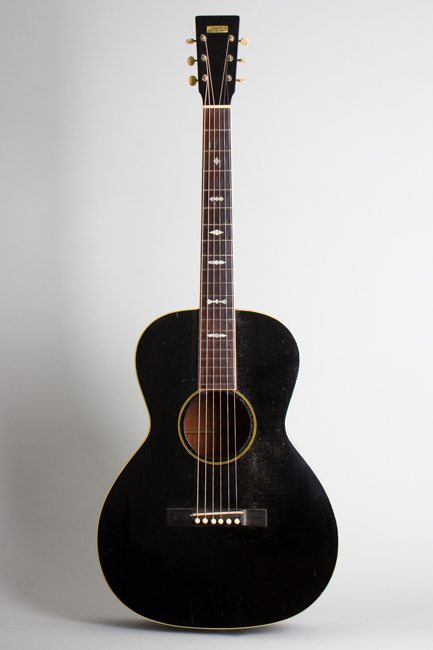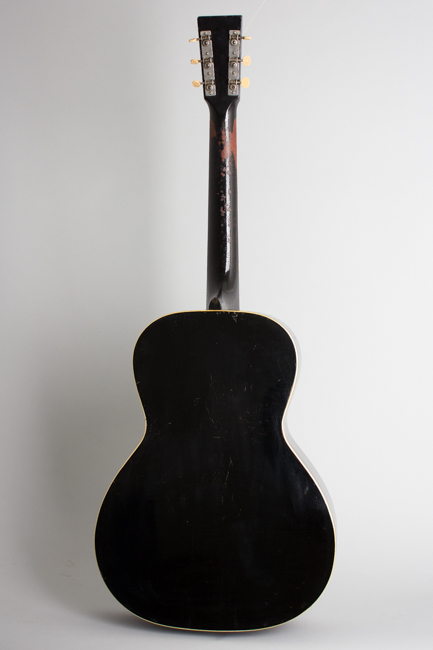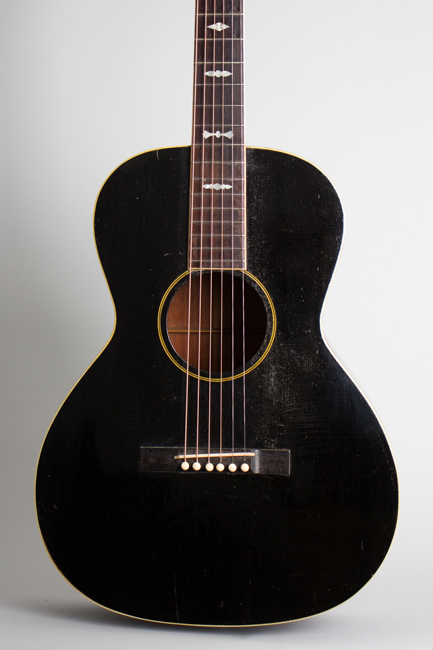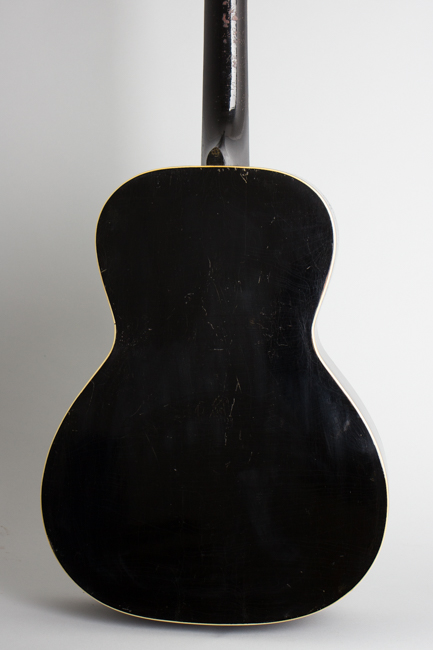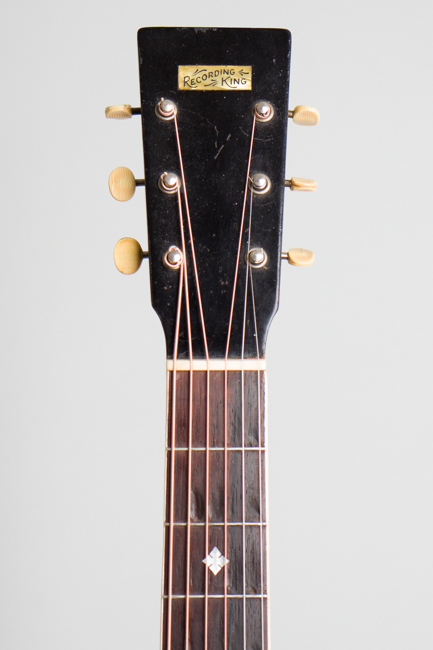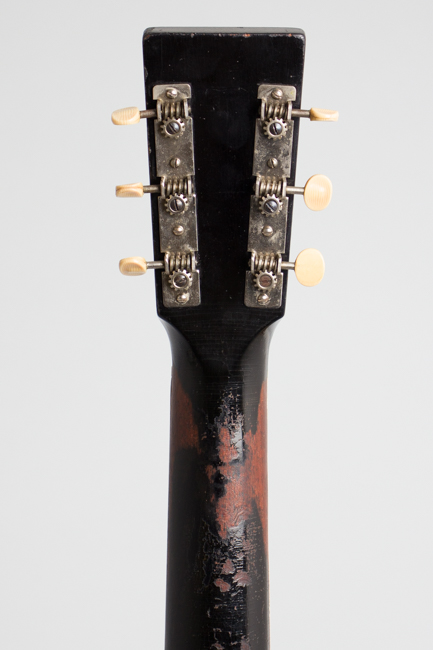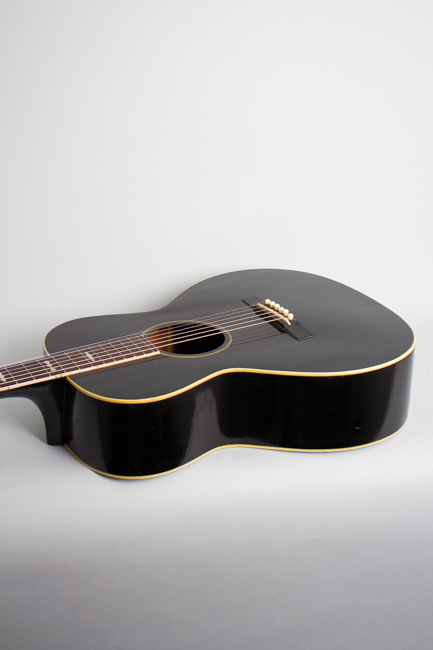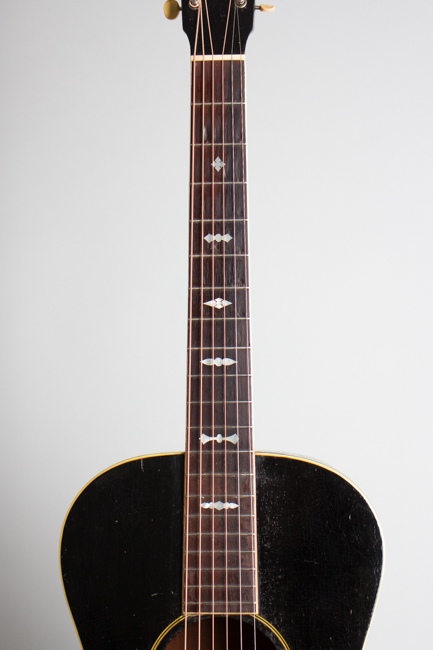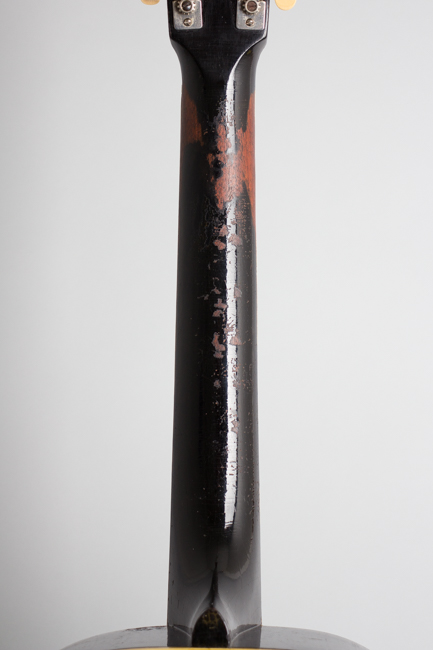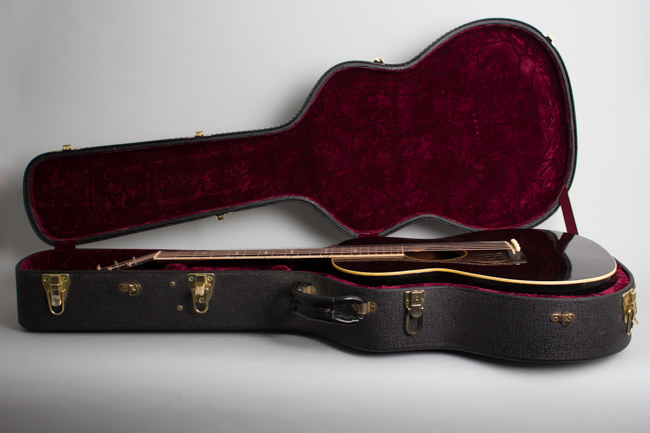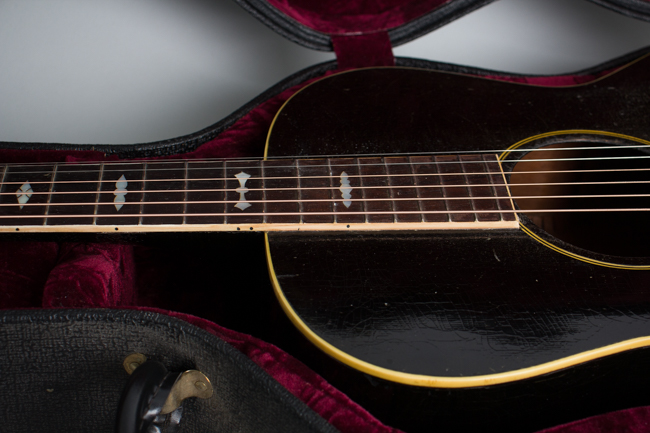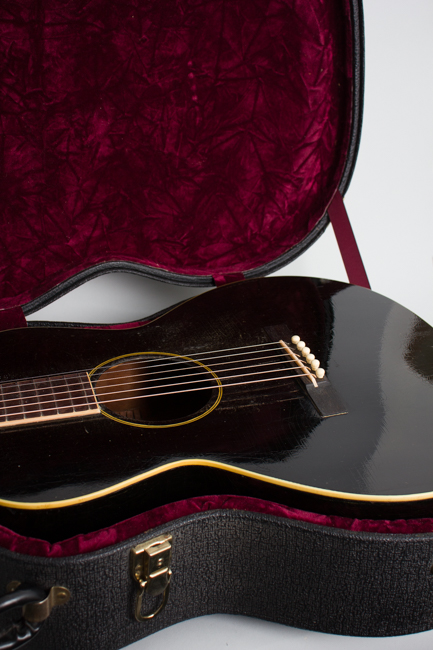Recording King Model 807 (Nick Lucas Style) Flat Top Acoustic Guitar, made by Gibson (1931)
This item has been sold.
Item # 11288
Prices subject to change without notice.
Recording King Model 807 (Nick Lucas Style) Model Flat Top Acoustic Guitar, made by Gibson (1931), made in Kalamazoo, Michigan, serial # 41, black lacquer finish, mahogany back, sides and neck, spruce top, rosewood fingerboard, black tolex hard shell case.
It was late 1930, the economy was collapsing everywhere. Gibson had parts and tooling set up to build their new improved large-body Nick Lucas Special, priced at $125. This very expensive deluxe flat top suddenly must have seemed VERY hard to sell as the Depression closed in. One solution? Assemble them with a plain headstock and no truss rod, spray them plain black and send them to Montgomery Ward to sell via mail-order catalog. Thus was born the Recording King Model 807, one of the finest practically unknown guitars Gibson ever produced.
This was a very short-lived model, only listed in the 1931 Ward's catalogs and gone by 1932. It was the first guitar Gibson built for Ward, preceded by a couple of banjos. It appeared billed as a "Nationally Famous Musical Masterpiece by Celebrated Makers" offered on an easy payment plan; the cash price was $48.00. It was advertised as a "$75 value" but even so was apparently too expensive for Ward's hard-pressed clientele in 1931; Gibson would go on to build many other instruments for the company but few as grand as this one. Ward's advertised this as a professional quality instrument (unlike most of their stock) and for once this was actually true.
The Nick Lucas Special Model was one of Gibson's gems in the late 1920s, a small but deep bodied flat top with deluxe trim. In 1929-30 it was enlarged with the rest of the flat top line to 14 3/4" widen retaining the unusually deep body as its trademark. This Ward's Model 807 is built on the exact same body as the earliest 1929-30 large Lucas, with mahogany back and sides and a thin, delicately X-braced spruce top. Instead of sunburst the Recording King is finished in black lacquer overall, with single binding on the top and back and a 3-ply soundhole ring. The surprisingly slim round-backed neck has the deluxe bound fingerboard with "Lucas" trademark shaped pearl inlay. The headstock is squared-off instead of the standard Gibson shape and unornamented except for a small neatly engraved "Recording King" pearl block. The tuners are plain strips with plastic buttons.
This is a great playing, huge sounding guitar. With its gleaming ebony finish and discreet tuxedo trim it is also quite a looker as well! It is even lighter than the Lucas model it is derived from, due primarily to the lack of a truss rod. Despite this the slim, round neck had remained quite straight for 90+ years. The bracing is also very light, with a delicate X and two slim tone bars behind it. This is a very rare guitar; there are no records of how many were sold but obviously not enough for Wards to keep it in the catalog for long! One of Gibson's most obscure pre-war flat top gems, the Recording King Model 807 is simply a delightful find and this is a very fine example.
Overall length is 38 1/2 in. (97.8 cm.), 14 3/4 in. (37.5 cm.) wide at lower bout, and 4 5/8 in. (11.7 cm.) in depth at side, taken at the end block. Scale length is 24 3/4 in. (629 mm.). Width of nut is 1 11/16 in. (43 mm.).
This is a lovely original guitar, showing only light wear and all original inside and out. The finish has typical checking overall with small dings, dents and scrapes with a few tiny touched up spots. There are some light pick marks to the top, mostly below the strings and soundhole. The back of the neck is the only area with notable finish wear down to the wood with some deeper feelable dinks and worn spots farther up along the center line.
There is only one crack repair, a small grain split to the top off the back edge. The small bridge remains original, as does the very thin maple bridge plate. Internally the somewhat delicate bracing remains original with some re-gluing evident and one small brace crack repaired. The original frets show some wear and there are some divots to the fingerboard in the lower positions but playability is not impeded. The neck has never been reset, the original bridge has been reglued but does not appear to have ever been cut down. The very thin top has survived remarkably well without heavy bulge distortion. This is simply a splendid, very rare instrument, a really unique piece of Gibson history and a superb player's instrument, just as Ward's advertised back in 1931. Overall Excellent - Condition.
It was late 1930, the economy was collapsing everywhere. Gibson had parts and tooling set up to build their new improved large-body Nick Lucas Special, priced at $125. This very expensive deluxe flat top suddenly must have seemed VERY hard to sell as the Depression closed in. One solution? Assemble them with a plain headstock and no truss rod, spray them plain black and send them to Montgomery Ward to sell via mail-order catalog. Thus was born the Recording King Model 807, one of the finest practically unknown guitars Gibson ever produced.
This was a very short-lived model, only listed in the 1931 Ward's catalogs and gone by 1932. It was the first guitar Gibson built for Ward, preceded by a couple of banjos. It appeared billed as a "Nationally Famous Musical Masterpiece by Celebrated Makers" offered on an easy payment plan; the cash price was $48.00. It was advertised as a "$75 value" but even so was apparently too expensive for Ward's hard-pressed clientele in 1931; Gibson would go on to build many other instruments for the company but few as grand as this one. Ward's advertised this as a professional quality instrument (unlike most of their stock) and for once this was actually true.
The Nick Lucas Special Model was one of Gibson's gems in the late 1920s, a small but deep bodied flat top with deluxe trim. In 1929-30 it was enlarged with the rest of the flat top line to 14 3/4" widen retaining the unusually deep body as its trademark. This Ward's Model 807 is built on the exact same body as the earliest 1929-30 large Lucas, with mahogany back and sides and a thin, delicately X-braced spruce top. Instead of sunburst the Recording King is finished in black lacquer overall, with single binding on the top and back and a 3-ply soundhole ring. The surprisingly slim round-backed neck has the deluxe bound fingerboard with "Lucas" trademark shaped pearl inlay. The headstock is squared-off instead of the standard Gibson shape and unornamented except for a small neatly engraved "Recording King" pearl block. The tuners are plain strips with plastic buttons.
This is a great playing, huge sounding guitar. With its gleaming ebony finish and discreet tuxedo trim it is also quite a looker as well! It is even lighter than the Lucas model it is derived from, due primarily to the lack of a truss rod. Despite this the slim, round neck had remained quite straight for 90+ years. The bracing is also very light, with a delicate X and two slim tone bars behind it. This is a very rare guitar; there are no records of how many were sold but obviously not enough for Wards to keep it in the catalog for long! One of Gibson's most obscure pre-war flat top gems, the Recording King Model 807 is simply a delightful find and this is a very fine example.
Overall length is 38 1/2 in. (97.8 cm.), 14 3/4 in. (37.5 cm.) wide at lower bout, and 4 5/8 in. (11.7 cm.) in depth at side, taken at the end block. Scale length is 24 3/4 in. (629 mm.). Width of nut is 1 11/16 in. (43 mm.).
This is a lovely original guitar, showing only light wear and all original inside and out. The finish has typical checking overall with small dings, dents and scrapes with a few tiny touched up spots. There are some light pick marks to the top, mostly below the strings and soundhole. The back of the neck is the only area with notable finish wear down to the wood with some deeper feelable dinks and worn spots farther up along the center line.
There is only one crack repair, a small grain split to the top off the back edge. The small bridge remains original, as does the very thin maple bridge plate. Internally the somewhat delicate bracing remains original with some re-gluing evident and one small brace crack repaired. The original frets show some wear and there are some divots to the fingerboard in the lower positions but playability is not impeded. The neck has never been reset, the original bridge has been reglued but does not appear to have ever been cut down. The very thin top has survived remarkably well without heavy bulge distortion. This is simply a splendid, very rare instrument, a really unique piece of Gibson history and a superb player's instrument, just as Ward's advertised back in 1931. Overall Excellent - Condition.
